Page 525 of 788

5256-3. Do-it-yourself maintenance
UK_AURIS/AURIS_HV_EE (OM12G88E)
6
Maintenance and care
Before recharging
When recharging, the 12-volt battery produces hydrogen gas which is flam-
mable and explosive. Therefore, observe the following before recharging:
If recharging with the 12-volt battery installed on the vehicle, be sure to dis-
connect the ground cable.
Make sure the power switch on the charger is off when connecting and dis-
connecting the charger cables to the 12-volt battery.
After recharging/reconnecting the 12-volt battery (vehicles with a smart
entry & start system)
Unlocking the doors using the smart entry & start system may not be possi-
ble immediately after reconnecting the 12-volt battery. If this happens, use
the wireless remote control or the mechanical key to lock/unlock the doors.
Start the engine with the engine switch in ACCESSORY mode. The engine
may not start with the engine switch turned off. However, the engine will
operate normally from the second attempt.
The engine switch mode is recorded by the vehicle. If the 12-volt battery is
reconnected, the vehicle will return the engine switch mode to the status it
was in before the 12-volt battery was disconnected. Make sure to turn off
the engine before disconnect the 12-volt battery. Take extra care when con-
necting the 12-volt battery if the engine switch mode prior to discharge is
unknown.
If the system will not start even after multiple attempts, contact any authorized
Toyota dealer or repairer, or another duly qualified and equipped professional.
CAUTION
Chemicals in the 12-volt battery
Batteries contain poisonous and corrosive sulfuric acid and may produce
hydrogen gas which is flammable and explosive. To reduce the risk of death
or serious injury, take the following precautions while working on or near the
12-volt battery:
Do not cause sparks by touching the 12-volt battery terminals with tools.
Do not smoke or light a match near the 12-volt battery.
Avoid contact with eyes, skin and clothes.
Never inhale or swallow electrolyte.
Wear protective safety glasses when working near the 12-volt battery.
Keep children away from the 12-volt battery.
Page 532 of 788
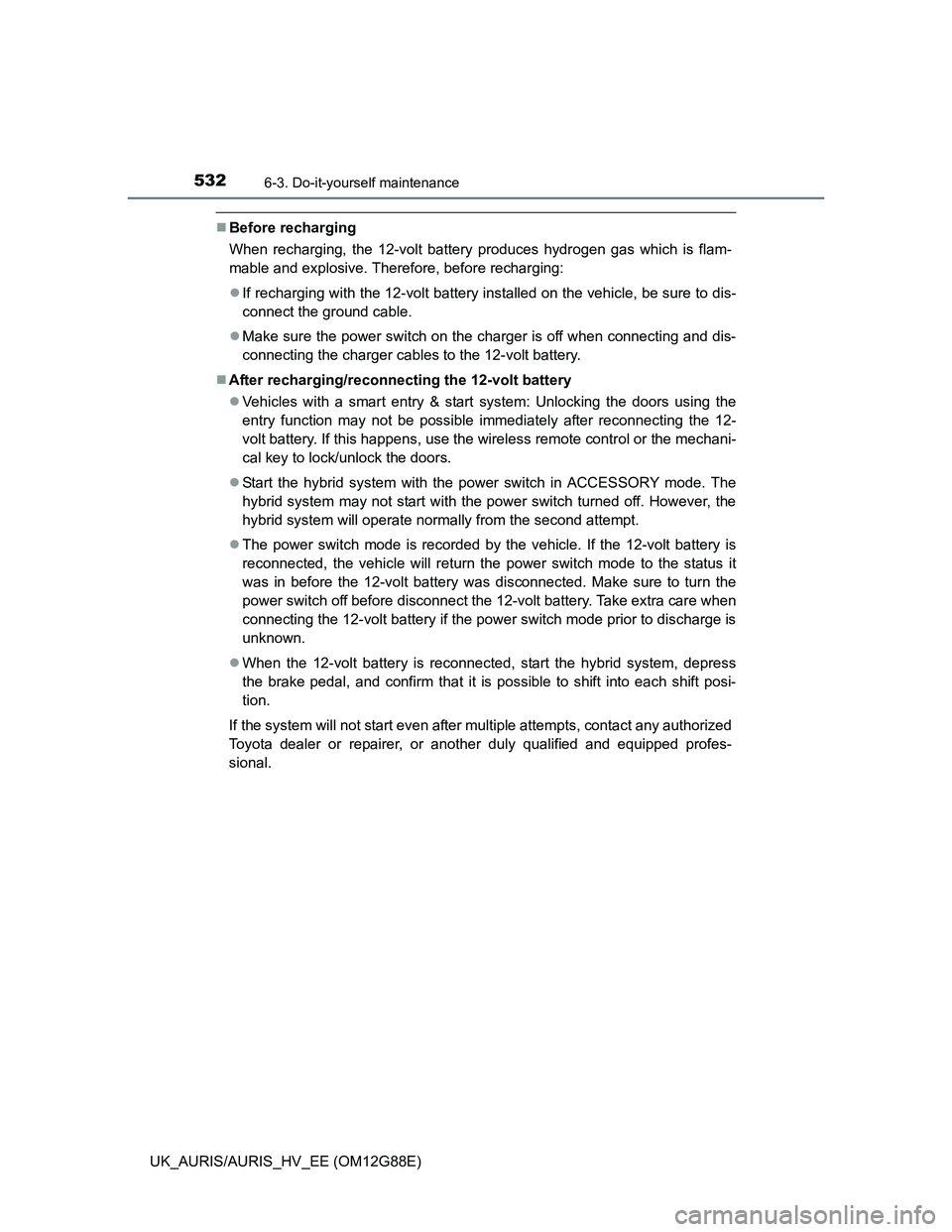
5326-3. Do-it-yourself maintenance
UK_AURIS/AURIS_HV_EE (OM12G88E)
Before recharging
When recharging, the 12-volt battery produces hydrogen gas which is flam-
mable and explosive. Therefore, before recharging:
If recharging with the 12-volt battery installed on the vehicle, be sure to dis-
connect the ground cable.
Make sure the power switch on the charger is off when connecting and dis-
connecting the charger cables to the 12-volt battery.
After recharging/reconnecting the 12-volt battery
Vehicles with a smart entry & start system: Unlocking the doors using the
entry function may not be possible immediately after reconnecting the 12-
volt battery. If this happens, use the wireless remote control or the mechani-
cal key to lock/unlock the doors.
Start the hybrid system with the power switch in ACCESSORY mode. The
hybrid system may not start with the power switch turned off. However, the
hybrid system will operate normally from the second attempt.
The power switch mode is recorded by the vehicle. If the 12-volt battery is
reconnected, the vehicle will return the power switch mode to the status it
was in before the 12-volt battery was disconnected. Make sure to turn the
power switch off before disconnect the 12-volt battery. Take extra care when
connecting the 12-volt battery if the power switch mode prior to discharge is
unknown.
When the 12-volt battery is reconnected, start the hybrid system, depress
the brake pedal, and confirm that it is possible to shift into each shift posi-
tion.
If the system will not start even after multiple attempts, contact any authorized
Toyota dealer or repairer, or another duly qualified and equipped profes-
sional.
Page 555 of 788
5556-3. Do-it-yourself maintenance
UK_AURIS/AURIS_HV_EE (OM12G88E)
6
Maintenance and care
Flathead screwdriver
Small flathead screwdriver
Lithium battery CR2016 (vehicles without a smart entry & start sys-
tem or push button start), or CR2032 (vehicles with a smart entry &
start system or push button start)
Vehicles without a smart entry & start system or push button start
Remove the cover.
To prevent damage to the key,
cover the tip of the screwdriver with
a rag.
Remove the depleted battery.
Insert a new battery with the “+”
terminal facing up.
Wireless remote control/electronic key
batter y
Replace the battery with a new one if it is depleted.
You will need the following items:
Replacing the battery
1
2
Page 557 of 788
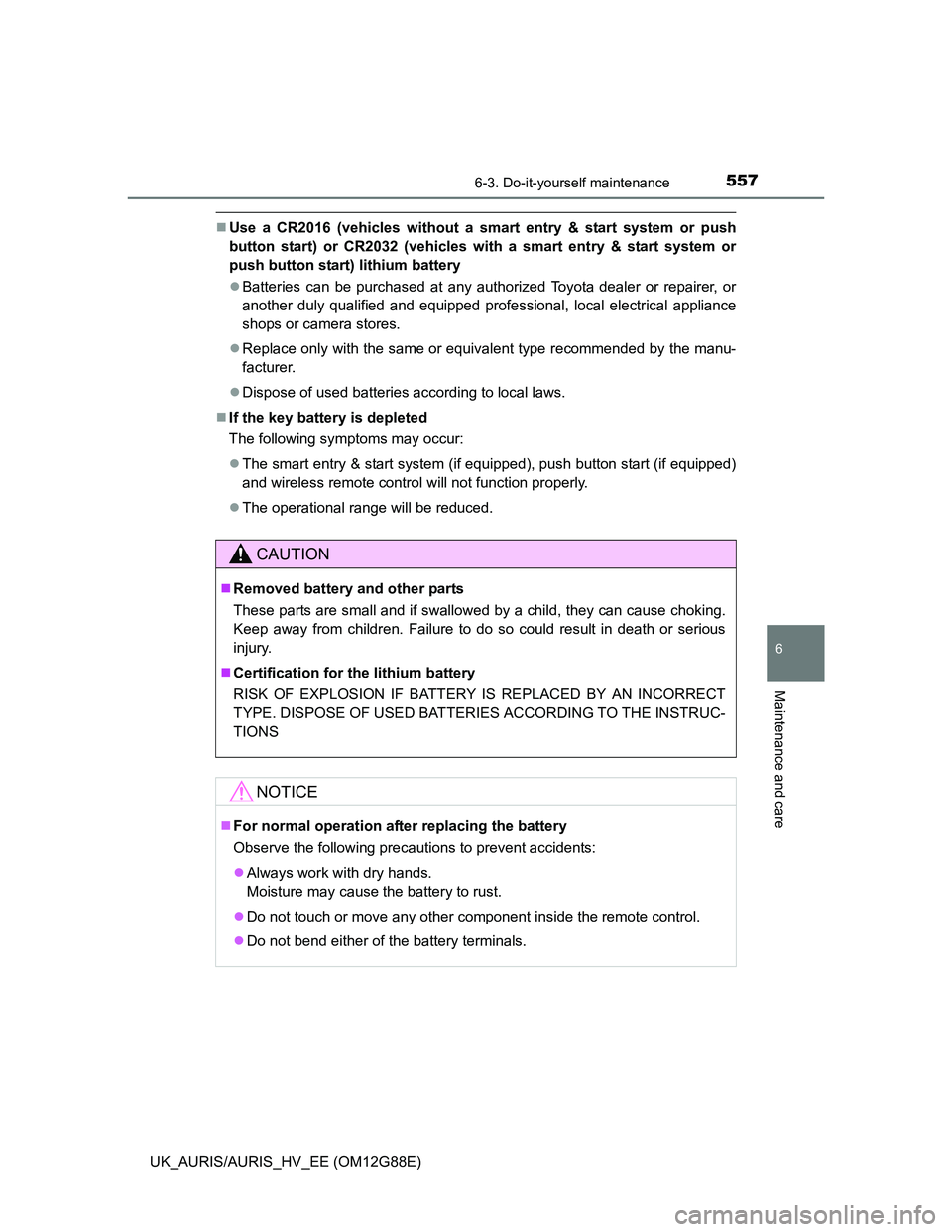
5576-3. Do-it-yourself maintenance
UK_AURIS/AURIS_HV_EE (OM12G88E)
6
Maintenance and care
Use a CR2016 (vehicles without a smart entry & start system or push
button start) or CR2032 (vehicles with a smart entry & start system or
push button start) lithium battery
Batteries can be purchased at any authorized Toyota dealer or repairer, or
another duly qualified and equipped professional, local electrical appliance
shops or camera stores.
Replace only with the same or equivalent type recommended by the manu-
facturer.
Dispose of used batteries according to local laws.
If the key battery is depleted
The following symptoms may occur:
The smart entry & start system (if equipped), push button start (if equipped)
and wireless remote control will not function properly.
The operational range will be reduced.
CAUTION
Removed battery and other parts
These parts are small and if swallowed by a child, they can cause choking.
Keep away from children. Failure to do so could result in death or serious
injury.
Certification for the lithium battery
RISK OF EXPLOSION IF BATTERY IS REPLACED BY AN INCORRECT
TYPE. DISPOSE OF USED BATTERIES ACCORDING TO THE INSTRUC-
TIONS
NOTICE
For normal operation after replacing the battery
Observe the following precautions to prevent accidents:
Always work with dry hands.
Moisture may cause the battery to rust.
Do not touch or move any other component inside the remote control.
Do not bend either of the battery terminals.
Page 564 of 788
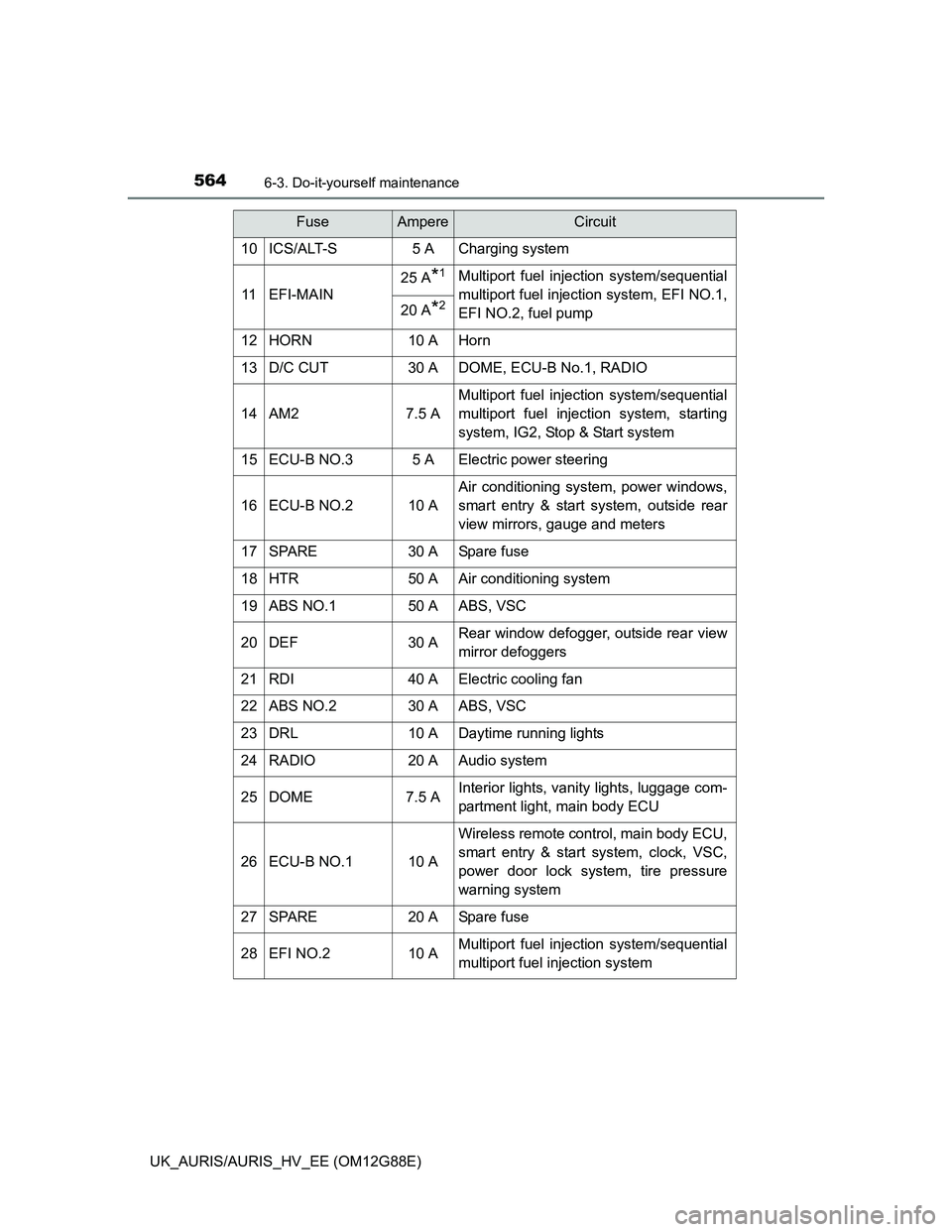
5646-3. Do-it-yourself maintenance
UK_AURIS/AURIS_HV_EE (OM12G88E)
10ICS/ALT-S5 ACharging system
11EFI-MAIN
25 A*1Multiport fuel injection system/sequential
multiport fuel injection system, EFI NO.1,
EFI NO.2, fuel pump
20 A*2
12HORN10 AHorn
13D/C CUT30 ADOME, ECU-B No.1, RADIO
14AM27.5 A
Multiport fuel injection system/sequential
multiport fuel injection system, starting
system, IG2, Stop & Start system
15ECU-B NO.35 AElectric power steering
16ECU-B NO.210 A
Air conditioning system, power windows,
smart entry & start system, outside rear
view mirrors, gauge and meters
17SPARE30 ASpare fuse
18HTR50 AAir conditioning system
19ABS NO.150 AABS, VSC
20DEF30 ARear window defogger, outside rear view
mirror defoggers
21RDI40 AElectric cooling fan
22ABS NO.230 AABS, VSC
23DRL10 ADaytime running lights
24RADIO20 AAudio system
25DOME7.5 AInterior lights, vanity lights, luggage com-
partment light, main body ECU
26ECU-B NO.110 A
Wireless remote control, main body ECU,
smart entry & start system, clock, VSC,
power door lock system, tire pressure
warning system
27SPARE20 ASpare fuse
28EFI NO.210 AMultiport fuel injection system/sequential
multiport fuel injection system
FuseAmpereCircuit
Page 570 of 788
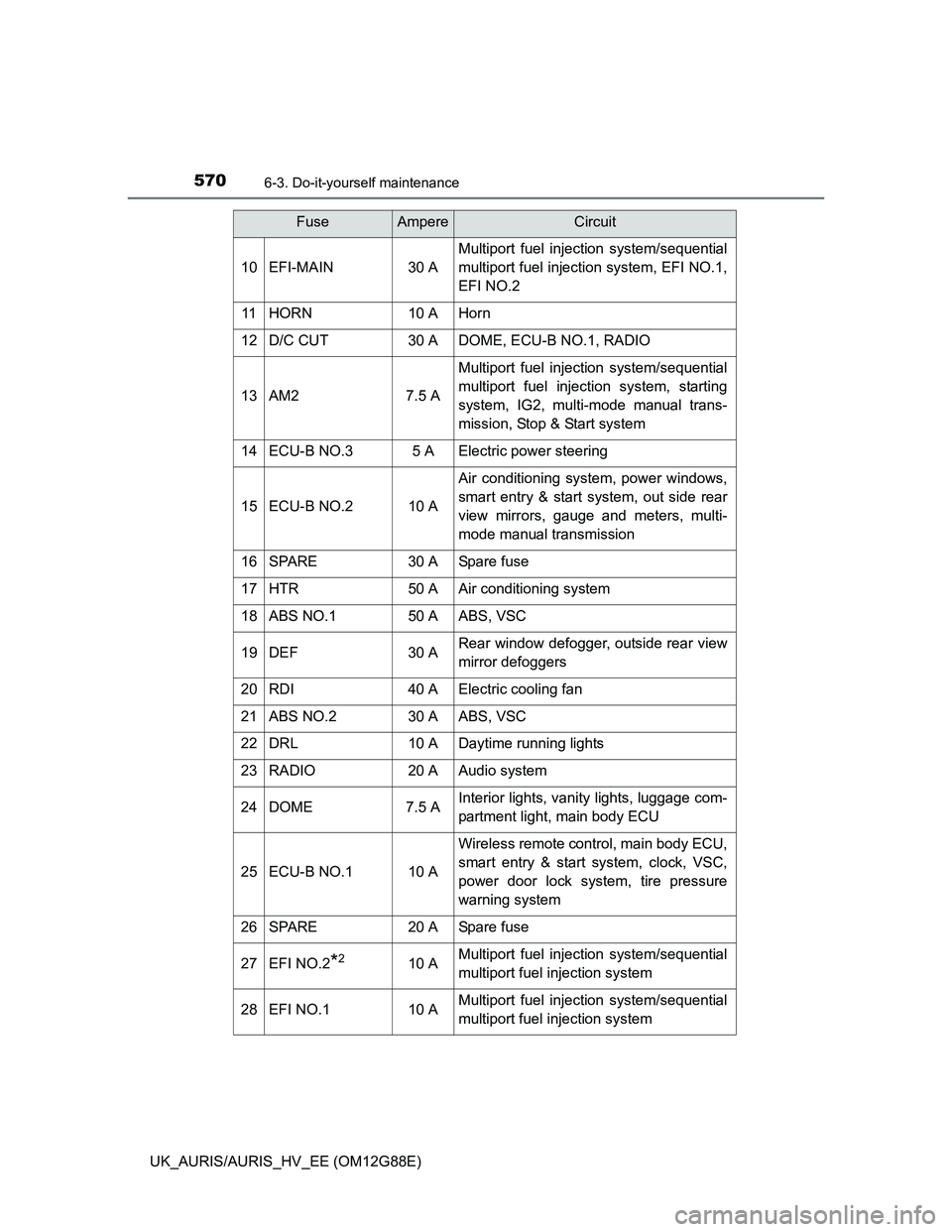
5706-3. Do-it-yourself maintenance
UK_AURIS/AURIS_HV_EE (OM12G88E)
10EFI-MAIN30 A
Multiport fuel injection system/sequential
multiport fuel injection system, EFI NO.1,
EFI NO.2
11HORN10 AHorn
12D/C CUT30 ADOME, ECU-B NO.1, RADIO
13AM27.5 A
Multiport fuel injection system/sequential
multiport fuel injection system, starting
system, IG2, multi-mode manual trans-
mission, Stop & Start system
14ECU-B NO.35 AElectric power steering
15ECU-B NO.210 A
Air conditioning system, power windows,
smart entry & start system, out side rear
view mirrors, gauge and meters, multi-
mode manual transmission
16SPARE30 ASpare fuse
17HTR50 AAir conditioning system
18ABS NO.150 AABS, VSC
19DEF30 ARear window defogger, outside rear view
mirror defoggers
20RDI40 AElectric cooling fan
21ABS NO.230 AABS, VSC
22DRL10 ADaytime running lights
23RADIO20 AAudio system
24DOME7.5 AInterior lights, vanity lights, luggage com-
partment light, main body ECU
25ECU-B NO.110 A
Wireless remote control, main body ECU,
smart entry & start system, clock, VSC,
power door lock system, tire pressure
warning system
26SPARE20 ASpare fuse
27EFI NO.2*210 AMultiport fuel injection system/sequential
multiport fuel injection system
28EFI NO.110 AMultiport fuel injection system/sequential
multiport fuel injection system
FuseAmpereCircuit
Page 704 of 788
7047-2. Steps to take in an emergency
UK_AURIS/AURIS_HV_EE (OM12G88E)
Use the mechanical key
(P. 155) in order to perform the
following operations:
Locks all the doors
Unlocks all the doors
If the electronic key does not operate properly (vehicles
with a smart entr y & start system or push button start)
If communication between the electronic key and vehicle is
interrupted (P. 164) or the electronic key cannot be used
because the battery is depleted, the smart entry & start system,
push button start and wireless remote control cannot be used. In
such cases, the doors can be opened and the engine can be
started by following the procedure below.
Locking and unlocking the doors
1
2
Page 713 of 788
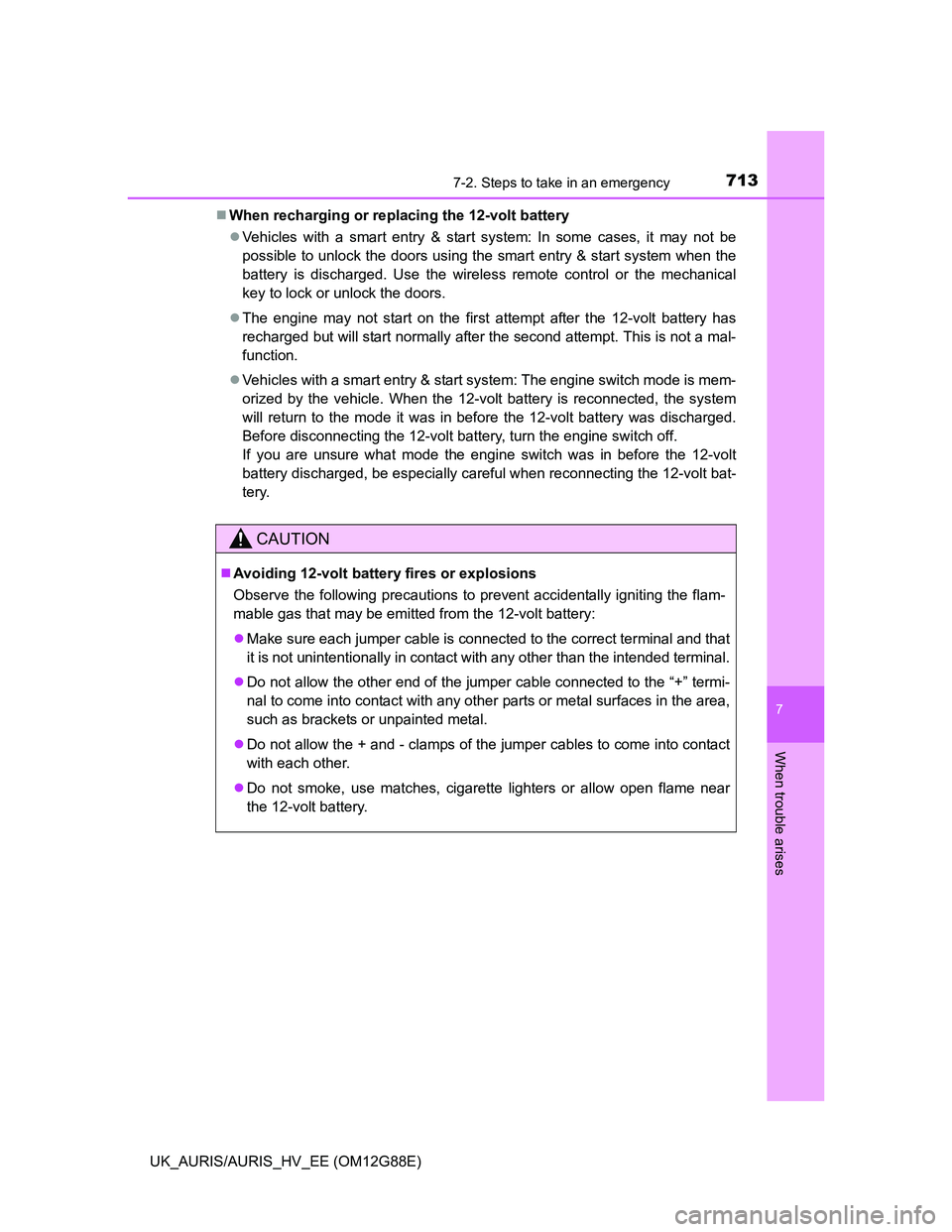
7137-2. Steps to take in an emergency
UK_AURIS/AURIS_HV_EE (OM12G88E)
7
When trouble arises
When recharging or replacing the 12-volt battery
Vehicles with a smart entry & start system: In some cases, it may not be
possible to unlock the doors using the smart entry & start system when the
battery is discharged. Use the wireless remote control or the mechanical
key to lock or unlock the doors.
The engine may not start on the first attempt after the 12-volt battery has
recharged but will start normally after the second attempt. This is not a mal-
function.
Vehicles with a smart entry & start system: The engine switch mode is mem-
orized by the vehicle. When the 12-volt battery is reconnected, the system
will return to the mode it was in before the 12-volt battery was discharged.
Before disconnecting the 12-volt battery, turn the engine switch off.
If you are unsure what mode the engine switch was in before the 12-volt
battery discharged, be especially careful when reconnecting the 12-volt bat-
tery.
CAUTION
Avoiding 12-volt battery fires or explosions
Observe the following precautions to prevent accidentally igniting the flam-
mable gas that may be emitted from the 12-volt battery:
Make sure each jumper cable is connected to the correct terminal and that
it is not unintentionally in contact with any other than the intended terminal.
Do not allow the other end of the jumper cable connected to the “+” termi-
nal to come into contact with any other parts or metal surfaces in the area,
such as brackets or unpainted metal.
Do not allow the + and - clamps of the jumper cables to come into contact
with each other.
Do not smoke, use matches, cigarette lighters or allow open flame near
the 12-volt battery.